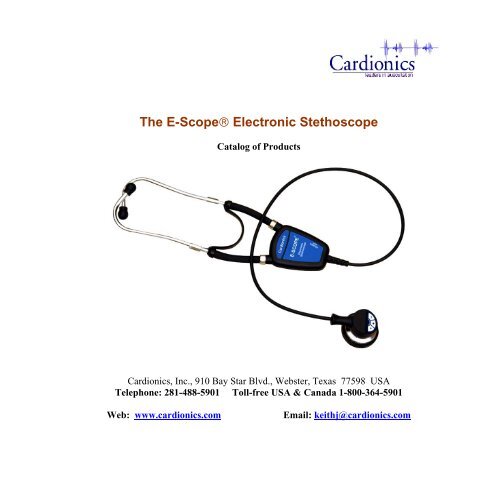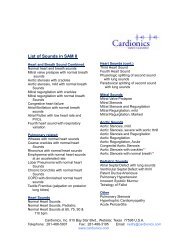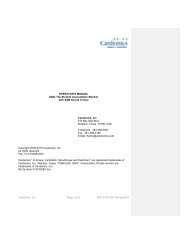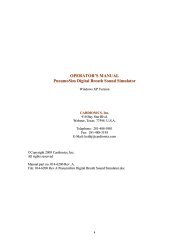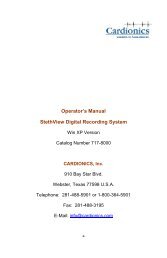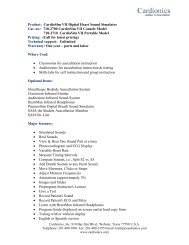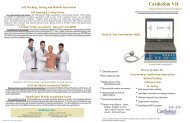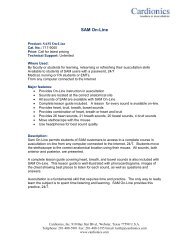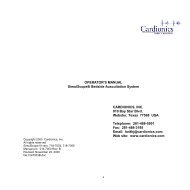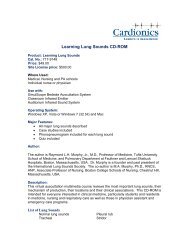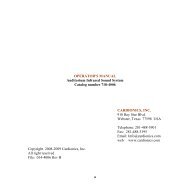The E-Scope® Electronic Stethoscope - Cardionics
The E-Scope® Electronic Stethoscope - Cardionics
The E-Scope® Electronic Stethoscope - Cardionics
You also want an ePaper? Increase the reach of your titles
YUMPU automatically turns print PDFs into web optimized ePapers that Google loves.
<strong>The</strong> E-<strong>Scope®</strong> <strong>Electronic</strong> <strong>Stethoscope</strong><br />
Catalog of Products<br />
<strong>Cardionics</strong>, Inc., 910 Bay Star Blvd., Webster, Texas 77598 USA<br />
Telephone: 281-488-5901 Toll-free USA & Canada 1-800-364-5901<br />
Web: www.cardionics.com Email: keithj@cardionics.com
Contents<br />
Description Page No.<br />
Summary chart........... .......................................................................1<br />
E-Scope Product description .............................................................2<br />
E-Scope for General Clinical Use……………………………. .......4<br />
EMS use in Ambulance (new)........................................................7<br />
In-the-ear (ITE) hearing aids ............................................................8<br />
Behind-the-ear (BTE) hearing aid………………………………… 10<br />
E-Scopes for Special use ...................................................................13<br />
Accessories for ITE hearing aid……..…… ………………………14<br />
Accessories for BTE hearing aids………………………………….16<br />
Accessories for Teaching......................……………………………18<br />
pocketMonitor Software (new)………………………………….19<br />
Service or technical information …………………………………..21<br />
Index ………………………………………………………………22<br />
®E-Scope is a registered trademark of <strong>Cardionics</strong>, Inc., Webster, Texas 77598<br />
Specialist & Pocket Monitor are trademarks of <strong>Cardionics</strong>, Inc. Webster, Texas<br />
77598<br />
b
Summary of Use – E-Scope <strong>Electronic</strong> <strong>Stethoscope</strong><br />
Where Used Cat. no. Description Recommended Page<br />
Accessories Number<br />
General clinical 718-7700* Professional Model None 4<br />
use 718-7740** E-Scope<br />
Pediatrics 718-7745*** Professional Model<br />
E-Scope with<br />
Specialist Pediatric<br />
Bell.<br />
None 5<br />
Veterinary use 718-7700 Professional model Low frequency 4<br />
E-Scope headphones<br />
With ITE 718-7710* Hearing Impaired None 8<br />
hearing aid 718-7750** E-Scope with<br />
headphones<br />
With BTE 718-7712** Hearing Impaired DAI or 10<br />
hearing aid<br />
E-Scope without Silhouette<br />
headphones, but<br />
with Specialist<br />
heads<br />
Cables<br />
With Implant 718-7712** Hearing Impaired Speech processor None<br />
Cochlear or Baja<br />
E-Scope without Cable set Call for<br />
headphones, but<br />
with Specialist<br />
heads<br />
information<br />
Special Use 718-7712** Hearing Impaired Ear buds 13<br />
with ear buds E-Scope without<br />
headphones, but<br />
with Specialist<br />
heads<br />
Ambulance/EMS 718-7800* E-Scope EMS with None 7<br />
use<br />
aviation style<br />
headphones<br />
* Supplied with Specialist Adult Diaphragm<br />
** Supplied with Specialist Adult Bell & Specialist Adult Diaphragm<br />
*** Supplied with Specialist Pediatric Bell, Specialist Adult Bell & Specialist Adult<br />
Diaphragm<br />
1
Description - Common to all E-<strong>Scope®</strong> Models<br />
Features and Benefits<br />
<strong>Cardionics</strong> supplies three basic types of E-Scopes – E-Scope Clinical Model, E-<br />
Scope Hearing Impaired Model and the E-Scope EMS. Various accessories are<br />
added to adapt these E-Scopes to different procedures and applications.<br />
Slim-line design. <strong>The</strong> E-Scope is a slim-line design that easily wraps around the neck<br />
when not in use. It is lighter than an acoustic stethoscope.<br />
Fingertip Control. All the controls for volume and heart sound or breath sound filters<br />
are on the head of the stethoscope making it easy for the user to set the volume or filter.<br />
Volume control. On the stethoscope head, there is a (+) and (–) symbol that allows<br />
the user to increase or decrease the sound level.<br />
Filter control. A frequency switch for heart sounds (45-900 Hz) and breath sounds<br />
(50-2000 Hz). This allows the listener to concentrate on a particular sound<br />
Automatic shut off. <strong>The</strong> E-Scope shuts off automatically at or about two minutes.<br />
<strong>Cardionics</strong> also has models with 8, 30 and 60 minute shut off timers available upon<br />
request at no additional charge at the time of order.<br />
Automatic volume restart. <strong>The</strong> E-Scope remembers the last volume setting so that<br />
when it is turned on, the volume will be set to the previous volume.<br />
Off-the-Shelf Battery. <strong>The</strong> E-Scope uses a standard off-the-shelf AAA battery that<br />
operates the E-Scope for 4-5 months assuming usage at 30 times per day, 6 days per<br />
week. Replacement batteries are available at any supermarket or drug store.<br />
Extra ear tips. <strong>The</strong> E-Scope is supplied with two additional types of ear tips<br />
so the user can select the most comfortable – soft rubber, hard plastic or mushroom type.<br />
Ability to change heads. Most electronic stethoscopes have a fixed diaphragm with an<br />
electronic switch to change to a bell. Most physicians, however, prefer a physical bell as<br />
is found on a standard acoustic stethoscope. A real bell allows the physician to listen to<br />
lower frequencies in a manner in which he/she is most accustomed. A bell is used to<br />
listen to the lower frequencies and has no diaphragm touching the skin. By pressing the<br />
bell on the skin, it can be stretched forming a natural diaphragm.<br />
Selection of diaphragms and bells. <strong>The</strong> E-Scope is supplied with an adult and pediatric<br />
diaphragm as well as three sizes of bells – adult, pediatric and infant.<br />
2
E-Scope <strong>Electronic</strong> <strong>Stethoscope</strong> – General Description<br />
Features and Benefits<br />
(Continued)<br />
Less amplification of room noise. <strong>The</strong> design of the E-Scope significantly<br />
reduces the amplification of unwanted outside room noise when used in the heart sound<br />
setting. When used in the lung sound setting, there is a little more noise introduced due<br />
to the wider frequency band.<br />
Maximum Amplitude. For the E-Scope II, the maximum amplitude or sound pressure<br />
level output without distortion is 120 dB at 100 Hz. This is about 30 times louder than an<br />
acoustic stethoscope.<br />
Operator’s Manual and Instructional CD-ROM. A complete Operator’s Manual as<br />
well as an informal instructional CD-ROM is included with each E-Scope.<br />
Specialist Bell and Diaphragm. <strong>Cardionics</strong> supplies a Specialist Adult Diaphragm as<br />
standard on all E-Scopes. An optional Specialist Adult Bell and Specialist Pediatric Bell<br />
are available. <strong>The</strong> performance of the Specialist Adult Diaphragm has a 3 dB (or 50%)<br />
higher output than the standard Diaphragm over the 20 to 200 Hz frequency range.<br />
Specialist is a trademark for a series of chest pieces machined from high-grade stainless<br />
steel.<br />
Specialist Pediatric Bell. <strong>The</strong> Specialist Pediatric Bell output has, on average, about<br />
60% higher than the standard pediatric bell over a 50 to 200 Hz frequency range for both<br />
heart and breath sound filter settings.<br />
Warranty: One year - parts and labor.<br />
Below is a photo and description of each model E-Scope supplied by <strong>Cardionics</strong>. <strong>The</strong><br />
description will be the same as above except when indicated.<br />
3
E-Scope <strong>Electronic</strong> <strong>Stethoscope</strong> - Clinical Model<br />
Cat. no. 718-7700<br />
Suggested Application: Professional Clinical Use.<br />
E-Scope <strong>Electronic</strong> <strong>Stethoscope</strong>, Clinical Model<br />
Specialist Adult Diaphragm (supplied)<br />
Description:<br />
Same as general description except that the Professional Model E-Scope (shown above)<br />
will be supplied with a Specialist Diaphragm as a standard item effective April 15, 2005.<br />
This E-Scope is designed for professional clinical use. In addition to the Specialist<br />
Diaphragm, this E-Scope is supplied with a pediatric diaphragm as well as three sizes of<br />
plastic bells – adult, pediatric and infant.<br />
E-Scope head with E-Scope head with<br />
Specialist Adult Bell Specialist Adult Diaphragm<br />
4
E-Scope <strong>Electronic</strong> <strong>Stethoscope</strong> - Pediatric Model<br />
Cat. no. 718-7745<br />
Suggested Application: Professional Clinical Use in Pediatrics and Adult patients<br />
.<br />
E-Scope <strong>Electronic</strong> <strong>Stethoscope</strong>, Clinical Model<br />
With Specialist Pediatric Bell, Specialist Adult Bell<br />
And Specialist Adult Diaphragm.<br />
Specialist Pediatric Bell, Specialist<br />
Adult Bell and Specialist Adult<br />
Diaphragm (supplied)<br />
Description:<br />
Same as general description except that the Clinical Model E-Scope (shown above) is<br />
supplied with three Specialist heads – the Specialist Pediatric Bell, Specialist Adult Bell<br />
and Specialist Adult Diaphragm. This E-Scope is designed for professional clinical use<br />
with emphasis on pediatrics. In addition to the Specialist heads, this E-Scope is also<br />
supplied with a pediatric diaphragm.<br />
5
E-Scope <strong>Electronic</strong> <strong>Stethoscope</strong> - Clinical Model with Specialist heads<br />
Cat. no. 718-7740<br />
Suggested Application: Professional Clinical Use.<br />
E-Scope <strong>Electronic</strong> <strong>Stethoscope</strong>, Clinical Model<br />
Specialist Adult Bell (supplied)<br />
Specialist Adult Diaphragm (supplied)<br />
Description:<br />
Same as general description except that the Clinical Model E-Scope (shown above) will<br />
be supplied with a Specialist Diaphragm and Specialist Bell. It is the same as model<br />
718-7700 except that it includes a Specialist Bell. This E-Scope is designed for<br />
professional clinical use. In addition to the Specialist Bell and Diaphragm, this E-Scope<br />
is supplied with a pediatric diaphragm.<br />
6
E-Scope EMS <strong>Electronic</strong> <strong>Stethoscope</strong><br />
Cat. no. 718-7800<br />
E-Scope EMS <strong>Electronic</strong> <strong>Stethoscope</strong><br />
Description:<br />
<strong>The</strong> E-Scope EMS is designed for use in an ambulance. It has aviation style headphones<br />
and a detachable stethoscope assembly. It is designed to provide maximum amplification<br />
of breath sounds and heart sounds with superior insulation from outside noise. <strong>The</strong> E-<br />
Scope EMS defaults to the breath sound mode for convenience of the paramedic. <strong>The</strong> E-<br />
Scope EMS is supplied with a Specialist Diaphragm, but Specialist Bell or Specialist<br />
Pediatric bell can be added.<br />
7
E-Scope <strong>Electronic</strong> <strong>Stethoscope</strong> - Hearing Impaired Model for ITE type hearing<br />
aids<br />
Cat. no. 718-7710 and 718-7750 –<br />
Suggested Application: With ITE (in-the-ear) type hearing aid<br />
E-Scope Hearing Impaired Model (Belt Model)<br />
Specialist Adult Diaphragm<br />
(Supplied on model 718-7710 and 718-7750)<br />
Specialist Adult Bell (supplied on Model 718-7750 only)<br />
8
Description:<br />
<strong>The</strong> E-Scope <strong>Electronic</strong> <strong>Stethoscope</strong>s, cat. no. 718-7750 or 718-7710 are designed for<br />
individuals with in-the-ear (ITE) type hearing aids. <strong>The</strong> dB level of the E-Scope is 130<br />
dB SPL. This is approximately 30 times louder than a normal acoustic stethoscope.<br />
<strong>The</strong> normal stethoscope earpieces have been removed and replaced with an external set<br />
of low frequency headphones. <strong>The</strong>se headphones are placed over the ears without<br />
removing the hearing aid. Amplification is supplied by both the hearing aid as well as<br />
the E-Scope. This has worked well for the vast majority of hearing aid users.<br />
<strong>The</strong>se headphones are intended for use with ITE type hearing aids. Each set of<br />
headphones are tested for low frequencies and serialized. If using a half-shell type<br />
hearing aid, we can supply these headphones with special leatherette covers that keep the<br />
headphone from touching the half shell hearing aid.<br />
Both of the above stethoscopes can be attached to a belt or lab coat with a removable belt<br />
clip.<br />
<strong>The</strong> two models shown above (cat. no. 718-7710 and 718-7750) differ only in that cat.<br />
no. 718-7750 is supplied with an Adult Specialist Bell and Adult Specialist Diaphragm<br />
while cat. no. 718-7710 is supplied with a Specialist Adult Diaphragm only. <strong>The</strong><br />
Specialist head are machined from high-grade stainless steel. <strong>The</strong>y provide a superior<br />
sound quality and have a heavier feel and less likelihood of outside noise.<br />
IMPORTANT NOTE: Hearing deficiencies vary considerably from person to<br />
person. Your audiologist is the best source of information on your particular<br />
hearing problem. You should consult with your audiologist if you have any<br />
specific questions about the use of your hearing aid with the E-Scope <strong>Electronic</strong><br />
<strong>Stethoscope</strong> or any similar device.<br />
9
E-Scope <strong>Electronic</strong> <strong>Stethoscope</strong> for BTE type Hearing Aids<br />
Cat. no. 718-7712<br />
Suggested Application: With a BTE (behind-the-ear) type hearing aid<br />
Description:<br />
E-Scope, cat. no. 718-7712 with<br />
Specialist Bell and Specialist Diaphragm<br />
<strong>The</strong> E-Scope <strong>Electronic</strong> <strong>Stethoscope</strong>s, cat. no. 718-7712 is designed for individuals with<br />
behind-the-ear (BTE) type hearing aids. It is used with one of the accessories mentioned<br />
below.<br />
Hearing aids are designed for speech and generally have a low frequency in the 250 Hz<br />
range. Heart sounds, however, have a much lower frequency (20 Hz to 650 Hz). <strong>The</strong><br />
first and second sound is approximately 70 Hz to 120 Hz and the third heart sound is<br />
approximately 50-60 Hz. Murmurs are generally in the 250-350 Hz range. <strong>The</strong>refore,<br />
the hearing aid itself may be a limitation.<br />
Hearing loss often occurs in the higher frequencies with lower frequencies still normal.<br />
Method #1. In these cases, an ear mold may be the answer. This method has been quite<br />
successful. <strong>The</strong> ear mold can be obtained from either Westone (1-800-525-5071) or<br />
Emtech (1-800-376-5719). It should have a large vent. <strong>The</strong>n, use with the E-Scope Belt<br />
Model, Cat. No 718-7710 or 718-7750. <strong>The</strong>se models are supplied with external<br />
headphones. <strong>The</strong> headphones are placed over the ear mold when using the E-Scope.<br />
This method bypasses the hearing aid and depends entirely upon the E-Scope for low<br />
frequency amplification.<br />
10
Method #2. A direct audio input cable (for one ear <strong>Cardionics</strong> cat. no.711-7123 for two<br />
ears, cat. no. 711-7125) can be connected from the E-Scope to the audio shoe (sometimes<br />
called a boot) of the hearing aid. Your audiologist will provide the audio shoe. <strong>The</strong><br />
direct audio input cable (DAI) connects the “Sounds output” of the E-Scope to the audio<br />
shoe that in turn snaps on to the hearing aids.<br />
E-Scope with DAI cable connected to<br />
audio shoe (boot) of a BTE hearing aid.<br />
DAI cable Euro plug connectors<br />
This photo shows the 3-prong Euro plug<br />
used on DAI cables<br />
11
Method #3. A silhouette (induction coil) can be connected to the E-Scope for one or<br />
both ears. <strong>The</strong> silhouette has worked well in many situations with BTE hearing aids.<br />
For one ear, use cat. no. 711-7133 and for two ears, Cat. no. 711-7135. This is a small,<br />
flat plastic device that loops behind the ear between the BTE and the head and is worn<br />
only when using the stethoscope. Turn the BTE to the “Telecoil” position when using the<br />
silhouette cord (induction coil).<br />
Silhouette cord for use with a BTE hearing aid.<br />
Fits between BTE and head. Connects to E-Scope<br />
Method #4. <strong>The</strong> <strong>Cardionics</strong> large headphones (<strong>Cardionics</strong> cat. no. 718-0408 cover the<br />
entire ear and the BTE hearing aid. <strong>The</strong>se have worked well in many cases. <strong>The</strong>se<br />
headphones fold up for ease of carrying. <strong>The</strong>y are somewhat bulky when not in use<br />
which is their major drawback.<br />
<strong>Cardionics</strong> large headphones, cat. no. 718-0408<br />
As in all cases where hearing loss is involved, the audiologist can advise you as to the<br />
best solution for your situation. If they are unfamiliar with electronic stethoscopes,<br />
please have them call <strong>Cardionics</strong> and I’ll put them in touch with an audiologist that is<br />
very familiar with the E-Scope.<br />
12
Low Frequency Ear Buds<br />
Cat. no. 718-0430 – Single ear bud<br />
Cat. no. 718-0425– Two ear buds<br />
Special use items<br />
Description:<br />
<strong>The</strong> Ear Buds can be attached to any E-Scope. <strong>The</strong>y have been tested and meet all<br />
existing specifications for low frequency sound reproduction. <strong>The</strong>y have been used<br />
in oral surgery by taping the stethoscope head to the patient’s chest. <strong>The</strong>n, the ear bud is<br />
placed in an ear mold fitted to the oral surgeon so listening can be done during surgery.<br />
E-Scope with Ear Buds<br />
(Supplied with one or two ear buds)<br />
Ear Bud only for one ear – cat. no. 718-0430<br />
Ear Bud only for two ears, cat. no. 718-0425<br />
13
Accessories for ITE hearing aids<br />
Low Frequency headphones<br />
Catalog No. 718-0405 (with bridge over head<br />
Catalog No. 718-0415 (with bridge behind the head)<br />
Low frequency headphones Active Style Headphones<br />
Cat. No. 718-0405 Cat. no. 718-0415<br />
Description:<br />
<strong>Cardionics</strong> supplies two types of lightweight, low frequency headphones. <strong>The</strong><br />
headphones shown above right are supplied as standard with the E-Scope Hearing<br />
Impaired Models, cat. no. 718-7710 and 718-7750.<br />
<strong>The</strong>y can be ordered separately under catalog no. 718-0405 or 718-0415. <strong>The</strong>se<br />
headphones are tested for low frequency. <strong>The</strong>y are serialized and the test data kept on<br />
record. <strong>The</strong>se headphones are placed on the ears. <strong>The</strong>y do not encompass the entire ear,<br />
but sit on the outside of the ear.<br />
If using a half-shell type hearing aid, we can supply the above headphones with special<br />
leatherette covers that keep the headphone from touching the half shell hearing aid and<br />
thereby reducing any feedback.<br />
14
Headphones, Large Encompassing<br />
Catalog No. 718-0408<br />
Description:<br />
<strong>The</strong>se headphones can be used with cat. no. 718-7710 or 718-7750 Hearing Impaired<br />
Model E-Scopes. <strong>The</strong>y completely encompass the ears. <strong>The</strong>y can be used with ITE or<br />
BTE type hearing aids.<br />
15
Direct audio input cable<br />
Cat. no. 711-7123 & 711-7125<br />
Accessories for BTE hearing aids<br />
Description: For use with BTE hearing aids<br />
. A direct audio input cable (for one ear <strong>Cardionics</strong> cat. no.711-7123 for two ears, cat.<br />
no. 711-7125) can be connected from the E-Scope to the audio shoe (sometimes called a<br />
boot) of the hearing aid. Your audiologist will provide the audio shoe. <strong>The</strong> direct audio<br />
input cable (DAI) connects the “Sounds output” of the E-Scope to the audio shoe that in<br />
turn snaps on to the hearing aids.<br />
Silhouette Cord (Induction coil)<br />
Cat. no. 711-7133 – single ear<br />
Cat. no. 711-7135 – two ears<br />
E-Scope with DAI cable connected to<br />
audio shoe (boot) of a BTE hearing aid.<br />
Description:<br />
A silhouette (induction coil) can be connected the E-Scope for one or both ears. <strong>The</strong><br />
silhouette has worked well in many situations with BTE hearing aids. For one ear, use<br />
Cat. no. 711-7133 and for two ears, Cat. no. 711-7135. This is a small, flat plastic device<br />
that loops behind the ear between the BTE and the head and is worn only when using the<br />
stethoscope. Turn the BTE to the “Telecoil” position when using the silhouette cord.<br />
Silhouette cord for use with a BTE hearing aid.<br />
Fits between BTE and head. Connects to E-Scope.<br />
16
pocketMONITOR Software for PC<br />
Cat. No.717-8055<br />
Accessories for BTE hearing aids (continued)<br />
pocketMONITOR Software<br />
for PC<br />
Description:<br />
<strong>The</strong> above photo illustrates a phonocardiogram displayed on a PC connected to the<br />
E-Scope. With individuals that have a severe hearing loss, a visual display is often very<br />
useful. <strong>The</strong> software (called pocketMONITOR) provides an excellent quality<br />
phonocardiogram while simultaneously hearing the sounds with the E-Scope. If the<br />
phonocardiogram has low frequency noise, it can be filtered to produce an appropriate<br />
display.<br />
<strong>The</strong> pocketMONITOR can:<br />
• Record<br />
• Playback at normal or half speed<br />
• Filter out noise<br />
• Display heart rate<br />
• Measure the length and frequency of a murmur to assist the user in differentiating<br />
between an innocent systolic murmur and the murmur of aortic stenosis.<br />
• Approximate the pressure gradient across the aortic valve.<br />
• Measure heart rate<br />
17
Stethophone<br />
Cat. no. 718-0500<br />
Description:<br />
Accessories for Teaching<br />
Stethophone for second listener<br />
For teaching with E-Scope<br />
<strong>The</strong> <strong>Cardionics</strong> Stethophone can be attached to any E-Scope. Its purpose is for training.<br />
Two listeners can hear a single patient simultaneously. <strong>The</strong> sound heard by both listeners<br />
is identical.<br />
18
pocketMONITOR for PC<br />
cat. no. 718-8055<br />
Description:<br />
Average spectrum is calculated for<br />
better spectral estimate of the murmur.<br />
• <strong>The</strong> duration of the spectral intensities<br />
above 250 Hz is measured by the<br />
vertical calipers, and in this case is<br />
reported to be 227 msec<br />
• <strong>The</strong> peak frequency (excluding the<br />
mechanical vibration of the valve) can<br />
be seen to be about 400 Hz.<br />
<strong>The</strong> pocketMONITOR is a software program that can be installed on any PC. It<br />
provides a display of the heart or breath sounds.<br />
19<br />
Spectrograph view of the<br />
murmur. Note the narrow band<br />
excitation corresponding to the<br />
h i l ib i f h i<br />
Cardiac murmur arising<br />
from a stiffened aortic valve.<br />
<strong>The</strong> user identifies the first<br />
instance while the software<br />
identifies all the other
pocketMONITOR can display, record and playback heart, breath or bowel sounds and<br />
full or half speed. It will also approximate the pressure gradient across the aortic valve.<br />
pocketMONITOR has a built-in library of sounds permitting the user to listen to<br />
prerecorded real patient heart sounds.<br />
One of the unique characteristics of pocketMONITOR is its ability to measure the<br />
frequency and duration of any murmur – a feature that is very helpful is differentiating an<br />
innocent murmur from one that is pathologic. This helps the user distinguish between an<br />
innocent systolic murmur and the murmur of aortic stenosis. pocketMONITOR can also<br />
assist the user identification of HCM (hypertrophic cardiomyopathy).<br />
pocketMONITOR allows the user to quickly identify and compare the sound under<br />
study with a large installed database of heart sounds and murmurs.<br />
20
Learning Cardiac Auscultation – CD-ROM with quiz<br />
Cat. no. 717-9147<br />
Description: This CD-ROM presents all common heart sounds and murmurs as well as<br />
their variations. It is possible to alter the volume of any part of a sound. For example, in<br />
listening to the murmurs of mitral stenosis, the middiastolic murmur can be played while<br />
muting the presystolic murmur for teaching purposes.<br />
In the above example, Physiological Splitting of the Second Sound is seen and heard.<br />
Breath sounds are added so as to heart the effects of respiration on the splitting. Heart<br />
rates of each sound are displayed.<br />
21
Sales, Service and Technical Information<br />
All E-Scope products are warranted for one year for any defects in manufacturing.<br />
Please see the warranty statement in the E-Scope Operator’s Manual.<br />
Service or Repairs<br />
Under warranty<br />
<strong>Cardionics</strong> will endeavor to repair any <strong>Cardionics</strong> product in a minimum of time<br />
at reasonable cost. If your E-Scope is under warranty and the problem one of a<br />
manufacturing defect, there will be no charge for the repair. However, there will<br />
be a $12.00 shipping and handling charge. This charge will be made on your<br />
credit card.<br />
Out-of-warranty:<br />
Most E-Scope repair charges for out-of-warranty repairs range between $25 and<br />
$50.00 plus shipping and handling charge of $12.00. <strong>Cardionics</strong> will call you<br />
with an estimate prior to making any out-of-warranty repair.<br />
Shipping charges:<br />
<strong>The</strong> customer is responsible for shipping the products to <strong>Cardionics</strong>. We<br />
recommend UPS, FedEx or insured US Mail. <strong>Cardionics</strong> cannot issue a pick up<br />
order.<br />
Exchange price: If you order an E-Scope, it may be exchanged for another<br />
model within 90 days of purchase. <strong>The</strong>re will be a $25.00 handling charge for an<br />
exchange. This is due to reprocessing and retesting and administrative work in<br />
serial number identification recording.<br />
Trial Unit. If an E-Scope is ordered and returned within 30 days for any reason,<br />
there will be a $25.00 restocking charge for reprocessing and retesting plus the<br />
outgoing freight charges.<br />
Technical Support. <strong>Cardionics</strong> will supply unlimited technical support<br />
22
A<br />
Accessories<br />
BTE................................................. 16<br />
ITE .................................................. 14<br />
C<br />
CD-ROM<br />
Learning Cardiac Auscultation ....... 21<br />
D<br />
DAI<br />
Direct Audio Input Cables .............. 16<br />
DAI cables<br />
Direct Audio Input .......................... 11<br />
Description............................................ 2<br />
E<br />
Ear buds .............................................. 13<br />
E-Scope EMS........................................ 7<br />
E-Scope Clinical Model........................ 4<br />
E-Scope Hearing Impaired Model<br />
ITE type ............................................ 8<br />
BTE type ......................................... 10<br />
E-Scope Pediatric Model ...................... 5<br />
E-Scope with Specialist heads .............. 6<br />
Index<br />
23<br />
H<br />
Headphones<br />
Large Encompassing....................... 12<br />
Large, encompassing....................... 15<br />
Light-weight.................................... 14<br />
L<br />
Learning Cardiac Auscultation<br />
CD-ROM......................................... 21<br />
P<br />
pocketMONITOR Software.......... 17, 19<br />
S<br />
Service and Repairs............................. 22<br />
Silhouette cord( Induction coil)… 12, 16<br />
Software, pocketMONITOR............... 17<br />
Specialist<br />
Bell.................................................... 3<br />
Diaphragm......................................... 3<br />
Pediatric Bell..................................... 3<br />
Stethophone......................................... 18<br />
T<br />
Teaching<br />
Stethophone..................................... 18<br />
Teaching with E-Scope....................... 18


